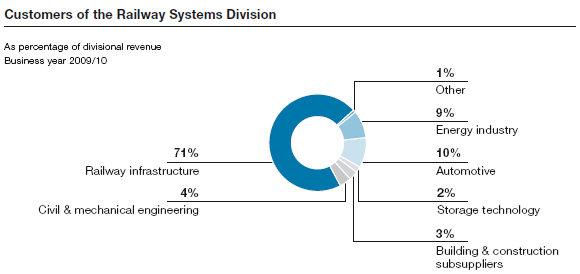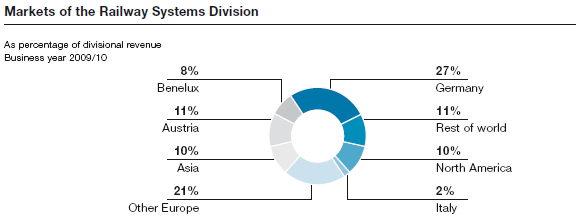During the past business year, the overall market environment was largely positive for the Railway Systems Division, although it was strongly differentiated in the individual segments due to their specific circumstances.

The railway infrastructure sector was characterized by an economic situation that was generally satisfactory—not least due to accelerated state-sponsored infrastructure programs.
Turnout technology displayed a stable business performance in Western Europe, and in Eastern Europe project activity picked up. The development of exports to overseas railway markets, especially exports of sophisticated Hytronics technology, was very satisfactory. Railway building projects in China, the Gulf states, and in the CIS states are particularly noteworthy; in the latter, business is improving due to the rising volume of goods traffic. In North America, however, economic stimulus programs have not resulted in a recovery in the railway infrastructure segment thus far; overall, demand has stabilized only at a low level or has even continued to decline, for example in the important freight segment (Class I railways).
Sinking pre-materials prices (for steel and rails) have resulted in a corresponding pressure on prices; this development was further exacerbated by growing competition, in particular from Asian suppliers.
The situation of the rail sector is similar, where, starting in the fall of 2009, far more aggressive competition has resulted in a sharp decline in prices, particularly within the scope of new tenders in Europe. It is not yet possible today to say where the bottom of this decline will be, particularly in the standard rail segment. While the past business year was widely characterized by a large order backlog from previous periods that provided a cushion and corresponding attractive margins, the second half of 2009/10 was marked by a growing number of postponed projects and contract awards. This trend was particularly conspicuous in the increasingly limited latitude in the budgets of the Central and Eastern European countries. The overall demand for rails in Europe fell by more than 10 percent, although this was partly compensated by higher exports to other markets.

After a difficult first half of the year that was marked by significant declines due to the economic crisis, the wire business segment showed a substantial upward trend in the second half of the business year. From the fall of 2009 onward, demand in all product groups and in almost all of the major customer industries has been very satisfactory. The long-term focus on niche products of the highest quality and the ability to secure mostly long-term supply agreements have paid off during this economic crisis. The gratifyingly favorable trend in incoming orders, including orders that are being rolled over into the new business year, has resulted in a high capacity utilization and enabled the reintroduction of corresponding production levels in the wire production segment.
The picture of the seamless tube segment for the business year 2009/10 is sharply differentiated. Although the difficult situation with regard to both prices and volumes improved substantially in the course of the year, from today’s vantage point, the sustainability of this trend has not yet been secured. In the OCTG (Oil Country Tubular Goods) segment, whose main market is the USA, the trend in rig counts, the market’s most important indicator, continues to be favorable and has resulted in a level of orders that is higher than expected. Demand for industrial tubes (mechanical engineering, automotive, boiler construction) was at a very low level in the early part of the business year, however, there was a subsequent slight rise in demand. Nevertheless, the average price level continues to be extremely modest; an improvement cannot be expected prior to the middle of the 2010 calendar year.
As in the previously described trends in the division’s other segments, the steel segment showed a gradual improvement in utilization of capacity and profit; as of the beginning of the third quarter of the business year, it again became possible to fully ramp up production due to growing demand from both divisional processing companies and external customers.


